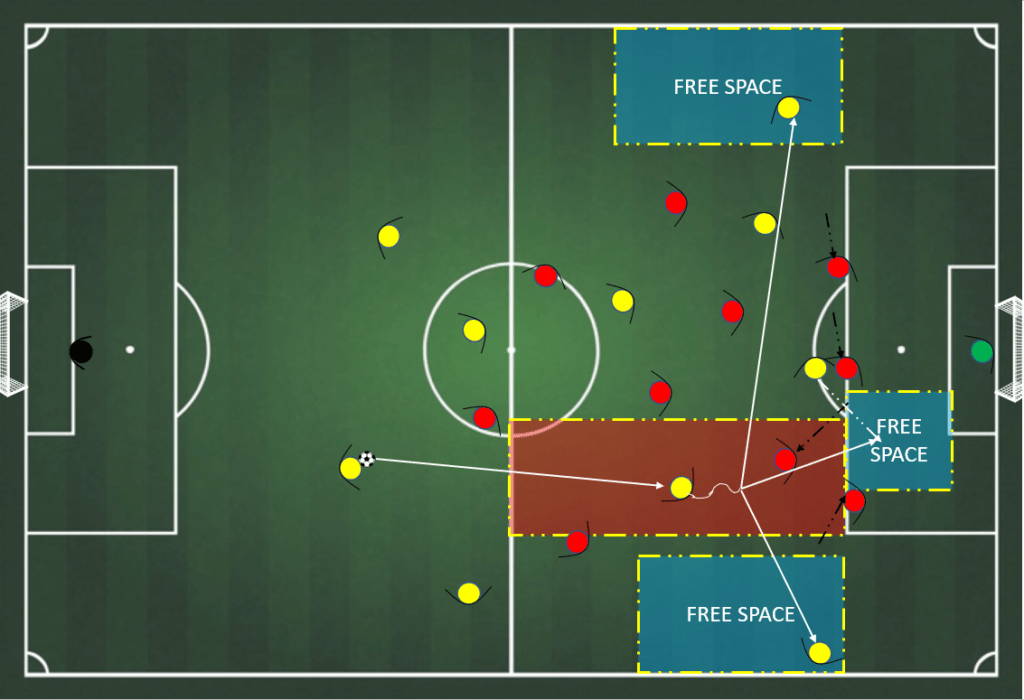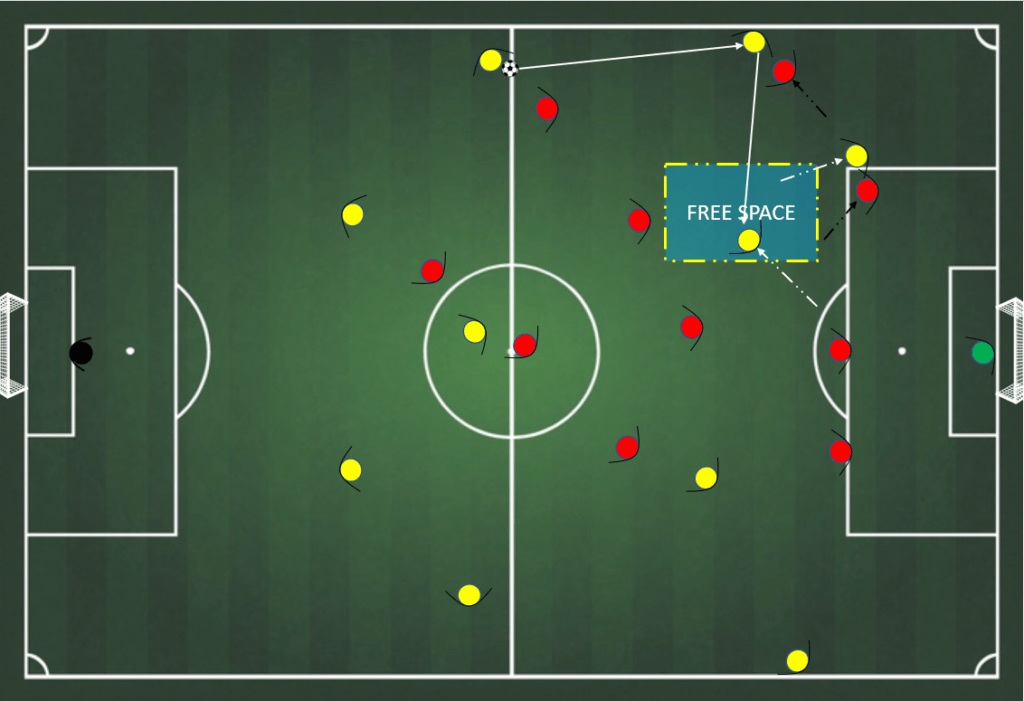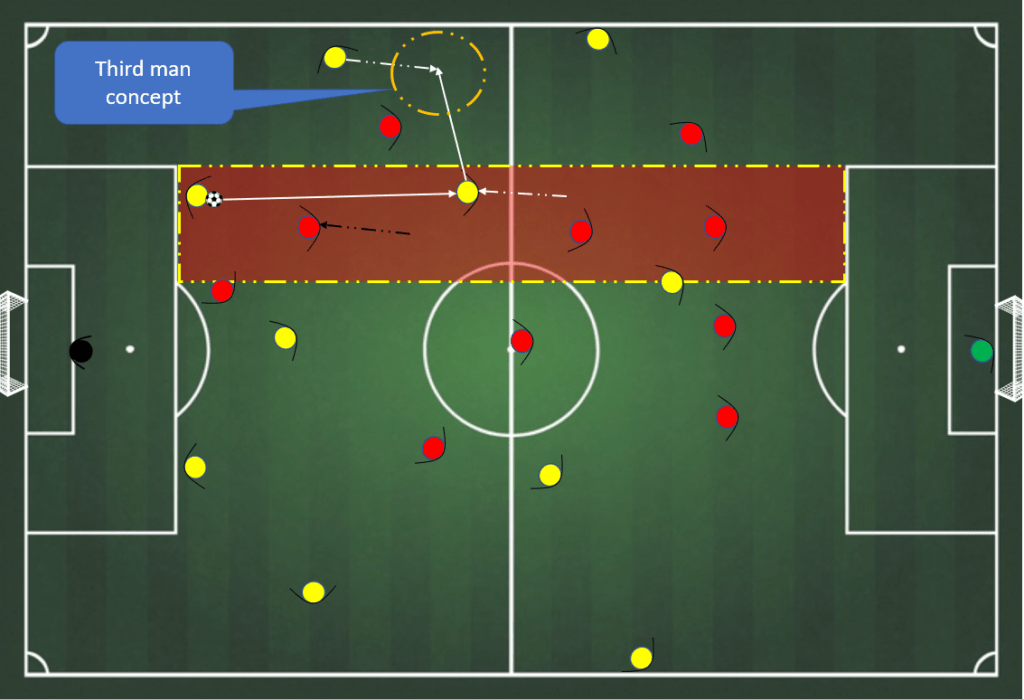Introduction
Football teams and coaches are continuously looking for new strategies to outsmart their rivals in the fast-paced and constantly changing game of football. The concept of using half-spaces in football is one such tactic that has attracted a lot of attention in the last few years. The specific concept is one of the fundamental aspects of positional play methodology. Teams can create attacking opportunities and disorganize the defensive system of their opponents by skillfully utilizing these areas. Coaches like Pep Guardiola with Barcelona, Bayern Munich, and the last years with Man City, Erik Ten Hag mainly with Ajax, Jurgen Klopp with Liverpool, and Roberto de Zerbi with Sassuolo and Brighton are bright examples of coaches who love to utilize these areas.
Football has historically underused half-spaces, often known as the channels between the center and the flanks. The use of formations that lack naturally occurring triangles and multiple lines, such as 4-4-2, limits the ability to create plays between the lines. However, intelligent coaches and tacticians have developed strategies to capitalize on the potential that these formations offer. Teams can open up passing lanes, disorganize the opposition’s defense, and create scoring opportunities by carefully positioning players in the half-spaces.
In this piece, I’ll go into the details of this tactic and consider how it might completely alter the way a team is playing.
Understanding the Half-Spaces in football
To fully grasp the power of half-spaces in football, it’s essential to understand their significance on the field. Positioned between the center of the pitch and the flanks, half-spaces provide a unique opportunity for players to exploit gaps between lines and between opponents. This strategic positioning opens up passing options, creates numerical and positional superiorities, and disrupts the opponent’s defensive shape.

Occupying the half-spaces in football allows teams to bypass the compact central area and build attacks with greater fluidity.
Moreover, by positioning multiple players in the half-spaces, the attacking team can create confusion and disorganize the opponent’s defensive formation putting challenges on them as to who is responsible to defend these areas.
Breaking the Lines
Placing attacking players strategically within the half-spaces gives to the teams a remarkable advantage – the capacity to break defensive lines and pass the ball behind the lines. By pushing players in these areas, teams can establish positional superiority over the opposing defense, overwhelming them and forging a plethora of goal-scoring opportunities.

To understand the significance of breaking the lines via the half-spaces, let us review a scenario. Envision a team in possession of the ball, with the opposition’s defense tightly compacted within the central space. Through the positioning of an attacking or central midfielder in the right half space, the team creates a dilemma for the opposition’s defense. Should the defending full-back track the attacker into the half-space, it creates a free space on the flank, thereby presenting an opportunity for an overlapping run from the team’s right-back. If the full-back decides to push on the player between the lines, a pass to the winger is free and situations 1 v 1 will emerge in wide area. A creative player such as Kevin De Bruyne or Bernardo Silva is ideal to take advantage of these spaces.
On the other hand, should the full-back opt to hold a wide position and cover the flank, it grants the attacking player situated in the half-space the chance to receive the ball unmarked, endowed with space and time to execute a decisive pass or shot.

A Positional Play coach can utilize rondos, positional games, and even a conditioned small sided game to train their players to identify any gaps between opponent’s lines and effectively utilize the concept of the half-spaces in football.
PEP GUARDIOLA – 85 PASSING, RONDOS, POSSESSION GAMES & TECHNICAL CIRCUITS DIRECT FROM PEP’S TRAINING SESSIONS

Looking to take your team’s performance to the next level?
- Warm-ups (training and match day)
- Speed & Agility (without/with ball)
- Technical Circuits
- Passing
- Rondos
- Juego de Posición (Positional Games)
- Possession Games
- Attacking Positional Patterns of Play
- Small to Large Sided Games
- Taken directly from Pep’s training sessions at Manchester City, Bayern Munich and FC Barcelona.
- This is your chance to practice and apply Pep Guardiola’s training sessions to develop your players’ speed, agility, technique and positional play – a unique opportunity to improve your team’s performance using practices from the highest level.
Stretching the defensive team
Teams that possess the capacity to effectively occupy the half-spaces can stretch horizontally the opposition’s defensive structure, thereby generating wider openings for their offensive players to capitalize on. This is very helpful especially when facing a team defending in a low block.
Through strategically situating their players within these regions, teams compel defenders to cover a larger expanse, resulting in vulnerabilities in the defensive line that can be exploited to attain goals.
Consider, for instance, imagine a wide player (winger) positioned on the left sideline, forcing the opposing full-back to push out toward the touchline. Meanwhile, the attacking midfielder or striker situates themselves in the half-space, ready to exploit the space left behind by the full-back. This creates a challenge for the defense: should they remain compact and close gaps in other areas, or should they shift to cover the half-space, thereby risking leaving spaces unguarded on the weak side or inside the box?

To further illustrate the concept of half-spaces in football, let’s consider a scenario where a team’s attacking midfielder receives the ball in the half-space, turns, and runs vertically inside the half-space. This movement not only creates a passing option for the player in possession but also attracts the attention of the opposition’s defenders. As the central defender push to press the player and the line shift to cover the gap, space opens up in other areas of the field, allowing the team to exploit these gaps and penetrate the defense.

By stretching the defense through the effective use of half-spaces, teams can create more opportunities for their attackers to receive the ball in dangerous positions.
A Positional Play coach can utilize rondos and positional games to train their players to identify any gaps between opponent’s lines.

Dynamic Interplay: A Fluid Style of Play
Utilizing the half-spaces in football encourages a more fluid and dynamic style of play, revolutionizing the way teams approach their attacking strategies. In these spaces, players have the freedom to interchange positions, creating confusion among defenders who struggle to track their movements effectively.
For example, imagine an attacking midfielder occupying the left half-space. When the ball is passed to the left winger the player makes a diagonal run behind the full-back drawing the attention of the opposing center-back. This opens up space centrally for the center forward who can drop back to receive with lots of free space to turn and try a shot or a penetration pass.

The fluidity and constant interplay between players in the half-spaces can disorient the opposition, making it harder for them to maintain a solid defensive structure.
Teams that fully embrace the idea of utilizing the half-spaces unlock exciting new possibilities in their attacking game. By encouraging players to explore and take advantage of the specific offensive zone, they can develop a dynamic and fluid attacking style that keeps the opposition on their toes.
Instead of relying only on predictable patterns and fixed positions, teams can constantly adapt and respond to the ever-changing flow of the game. The fluid interplay in the half-spaces allows for quick combinations, one-touch passes, and intricate build-up play that can dismantle even the most organized defenses. By maximizing the potential of the half-spaces, teams can completely change their style of play and unleash the unconventional power that lies within these areas of the pitch.
Overcoming High Press
When teams face intense pressing from the opposition, half-spaces become invaluable escape routes. These areas provide a sanctuary for players to receive the ball and evade the pressing defenders. By strategically positioning players in these half-spaces, teams can create options for more vertical than horizontal passes and outlets that allow them to bypass the pressure and maintain possession.
Let’s imagine a scenario where a team is being pressed aggressively by their opponents. The opposition players are pushing up putting intensive high pressure on the ball carrier during the build-up. In such situations, utilizing the half-spaces becomes crucial. For example, an attacking midfielder can drop deeper into the half-space to provide an angle for the defender under pressure. This creates a passing option that bypasses the immediate pressure and using the third-man tactical concept allows the team to move the ball to free spaces.

Utilizing half-spaces as escape routes helps teams to build up from the back and progress through the thirds. The team in possession can break the opposition’s pressing lines and access the more advanced areas of the pitch.
Conclusion
In conclusion, the incorporation of the half-spaces in football concept has brought about a profound transformation within the game. Teams possess the ability to take down any defending team, fabricate opportunities to score a goal, and completely redefine their style of play. Half-spaces offer avenues for passing, elongate the defensive structure, and foster a fluid and harmonious interaction among players. By embracing these tactics, teams can disorient defenders, penetrate defensive barriers, and expertly exploit vulnerabilities within the opposing defense.
Moreover, half-spaces serve as escape routes during moments of intense pressing, effectively disrupting the opponent’s attacking strategies when employed in a defensive manner. The strategic utilization of half-spaces has truly revolutionized football, unveiling new dimensions and fundamentally reshaping the nature of the game.

